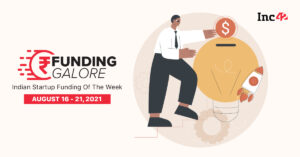What do you want to be when you grow up? Forget about getting astronaut and outer space as an answer. Today’s kids want to be stars. More than 30% of kids want to be YouTubers when they grow up (1), which is 3x times more than astronauts.
Earning primary income as content creators is now a reality for more than 50 million people (2), nearly three times more than in 2017 (3).

Previously, creators were treated as individual entities who monetized from one platform, such as Youtube, Instagram, and TikTokers. However, today, many of those respective creators have emerged into fully-fledged businesses, productizing and diversifying in several ways.
These are known as multi-SKU creators.
An entire ecosystem is rising to support multi-SKU creator businesses. Today, let’s look at the often overlooked creators’ back office of financial services.
The Start of New Era for Creators
By now, one should have heard about the creator economy.
Last year acted as a massive catalyst event for a transformation that started a decade ago with platforms like YouTube, Etsy, Kickstarter, and others. Notably, YouTube was the first organization to use the term ‘creator’ for its native talent, using the platform to create content, develop, and monetize the audience.
Fast forward to 2021; today, the content ecosystem has grown dramatically. More than 200 startups are building for creators, and tens of millions of people call themselves content creators. Legacy platforms such as YouTube pays billions of dollars in revenue share to its creators every quarter (4), and newcomers are advancing creator monetization a center point from the get-go. Heard about Clubhouse?
Read Also: Meet Clubhouse Setting the Buzz Across the Internet
These days, several columnists and reports are going indie, detaching themselves from their employers and signing up with platforms like Medium, Patreon, and Substack. Here they are getting paid for their writing by their readers.
Much of the hype is on the movement’s sustainability, focusing on the math of converting followers and readers into paying subscribers. ‘If he can get 10% of his 500k Twitter followers to pay 100 USD a year…’ such simple analysis that characterizes both the glass half-full and half-empty outlooks has benchmarked against either their previous salary or some notion of economic success.
Even though the framing is not wrong, it is incomplete. We believe that only a few Substack writers would make 100% of their income from their newsletters and subscribers. It won’t be a failure of the platform. Instead, it is related to the movement of the creation itself.
Creators have also evolved and matured over the course. There is a new cohort of creators today. The most significant ones shape a new type of small business, led by visionary internet entrepreneurs monetizing audiences online via a mix of content, product, community, services, aka the multi-SKU creators.
We have never been more excited about where it is headed. The future belongs to creators, and society requires more of them to build a more solid web (5).

The Opportunity
Clubhouse, NFTs could be getting all the headlines. However, fintech enablers are the next unicorns, with the industry expected to grow from 7.3 billion USD in 2018 to over 43 billion USD in 2026.
A new wave of customer-facing tech firms offers a wide range of add-on financial services to their core offering while behemoths such as Amazon, with its Amazon Lending and Amazon Cash. And Apple, with its Apple credit card, continues to pour capital into the financial services segment.
Last year, Google announced that it would expand its digital banking services into the United States (6). It collaborated with more than six banks and added its existing banking partners SFCU and Citi to provide bank accounts to Google Play users.
Fintech infrastructure firms, also referred to as ‘fintech enablers,’ build white-label, modularized banking infrastructure, such as core systems, licensing, payment processing, and compliance services that consumer-facing companies can rent out.
Space is still evolving, and there is ample opportunity for new players to grow and support fintech. Nevertheless, fintech would be beneficiaries of the infrastructure, any industry in which money moves or needs managing are rising for grabs.
According to The Sift report (7), everyone from house purchases, law companies overseeing M&A, to general supplier payments, and corporate back-offices managing salaries would use custom-built embedded fintech solutions.
There are also several opportunities when it comes to financial services for creators.
Accounting and Taxes
Full-time creators combine the complexity of a small business and freelancer’s nature, establishing a requirement for QuickBooks or TurboTax for content creators.
Such tools can also model bookkeeping software for startups. For instance, Pilot (8) caters to mid-size companies and startups by providing them services that they often lack, such as assistance with claiming R&D tax credits or on-demand CFO services.
Apart from CFO services, tax, and bookkeeping for growing businesses, it also offers a platform for accurate financial reports and automated accrual basis bookkeeping to create on-demand and error-free reports, enabling enterprises to reduce cost, time, and labor associated with conventional outsourced bookkeeping practices.
The company recently secured a 100 million USD funding round led by Bezos Expeditions, a venture capital firm backed by Jeff Bezos, a hedge fund, Whale Rock Capital, with participation from Index Ventures and Sequoia, hitting a 1.2 billion USD valuation.
Here are some creator-centric feature ideas one can incorporate:
- Collating tax policies across platforms. For instance, YouTube’s updates in reporting
- Assistance in determining what counts as income sources, including affiliate links, product gifting, and more
- Guidance on what business expenses count as tax write-offs, including technology, marketing costs, and trademark and copyright fees
Read Also: YouTube Creator Outside of the US? Be Ready to See Revenue Drop
Income Share Agreements
Two of the most significant roadblocks for creators are education and funding. That’s where ISAs, Income Share Agreements come into play. It offers to fund for education that students pay back after getting a job.
A Lambda for content creators has enormous revenue potential. Notably, there are almost two times more creators as software developers globally (9), and YouTube alone has paid over 30 billion USD to creators over the past three years.
One existing ISA model is Podfund (10). It offers grants between 25k to 150k USD and mentorship, technology, and community for growth to podcasters. Creators retain 100% ownership while sharing about 7 to 15% of income for 3 to 5 years.
Podfund, backed by TechNexus, is a venture investment firm that builds new industries at the rising digital economy’s outer edges. The platform operates as a venture incubation and collaboration platform. It calls itself one of the largest audio venture investors across the globe.
Entrepreneurs can also apply similar models across different creator mediums while focusing on scalability and growth.
Revenue Sharing
The emergence of creative collaborations, for instance, the Every bundle (11) or The Audio Collective (12) for Clubhouse, offers with it a whole new host of financial questions surrounding splitting earnings and ownerships.
One startup solving the issue is Stir (13). The platform enables content creators to manage their revenue streams, share funds with collaborators, and organize their analytics.
The San Francisco-based financial management platform for producers and writers secured an undisclosed amount of Series A funding at a valuation of 100 million USD, led by Andreessen Horowitz.
The valuation of Stir and another previous unreported financing of a startup called Karat (14) indicates how significant investors are making bets on services and software for the booming creator economy, made up of tens of millions of people who are building businesses from YouTube and other social media platforms that enable them to make subscription revenue.
Stir combines audience and financial data across different social media platforms and collaborators and easily splits revenue between Shopify, YouTube, Podcasts, Newsletters, and Twitch.
There is still room to apply Stir’s revenue-sharing model to other creator platforms such as blogs, Instagram, and TikTok. Even though Stir helps with revenue sharing, it doesn’t address the company equity. It means that there is an opportunity for the creator-first version of Carta (15).
Carta is a transfer agent for private organizations that enable seed-stage to pre-IPO firms to manage their equity electronically with their stakeholders’ participation, such as employees, auditors, shareholders, and legal counsel. The firm digitizes paper stock certificates, warrants, stock options, and derivatives to build a real-time image of who owns what at a company.
Since its inception in 2012, the California-based firm has received over 630 million USD fundings from a cohort of investors such as Draper VC, K9 Ventures, Expansion VC, Subtraction Capital, Elefund, Scott Banister, Kima Ventures, XG Ventures, Structure Capital, and Andy Palmer.
Catra makes it easy for investors, companies, and workers to manage startup equity arrangements. It has achieved more than 150 million USD ARR and is valued at 7 billion USD.
Another example in the space is Karat. Founded in 2019, the California-based startup is relatively new. It promises to create better banking products for influencers and content creators who make a living on Instagram, YouTube, Twitch, and other online platforms.
The startups recently secured 4.6 million USD funding from Kevin Lin, the co-founder of Twitch, SignalFire, CRV, Coatue, and YC. Last year, it had unveiled its first product, the Karat Black Card.
According to Eric Wei, the co-founder of Karat (16), even though several creators make significant incomes, banks rarely understand their business or offer them a good term when they seek capital.
He further argues that creators have also turned suspicious of potentially scammy financial deals to the point that if someone tried to give out capital, any good creator wouldn’t take it, even if it comes with no strings behind it.
With the Karat Black Card, the startup offers creators a credit card they can utilize for their business-related expenses. When creators get the approval, they receive a 250 USD bonus to apply to any future purchases of electronics and pieces of equipment. The card comes with custom designs, 2 to 5% cashback, and advances on sponsorship payments.
In short, it has built an underwriting model that works for digital creators. Instead of looking at credit scores, which traditional financial institutes care a lot about, it focuses on the size of the creator’s following, their revenue, and whether they are ‘business savvy’ or not.
One can also work with a similar model and even offer a vertical financial and biz ops experience. There are estimates that Karat has more than one million creators’ potential customer base, and eventually, they are going to want more than a black card.
Author’s Words
Ever since Chris Anderson, the editor of Wired magazine, first published his ‘Long Tail’ theory in 2004, the idea has been endlessly contradicted, debated, and reinforced. His idea was that the internet’s removal of physical limitations, such as local audiences, scares self space, would empower niche products and content creators to thrive (17).
The phenomenon has been confirmed in the search category with Google, revealing that 15% of all searches have never been searched before, a state that has remained stable since 2013 (18).
Most content platforms at present are filled with countless examples of people achieving massive success. It should come as no surprise. Last year, David Dobrik, a YouTube creator, had 275K USD month AdSense checks for an average of 60 million views. On Substack, the top creators are clocking more than 7 million USD collectively annually. Charli D’Amelio, who recently came to be the first TikTok creator to cross 100 million followers, is worth about four million USD at age 16. She started on the platform only a year and a half ago (19).
Creator platforms thrive when they offer an opportunity for anyone to grow and succeed. When creators don’t get the chance, the fate of these platforms turns precarious. Vine is an excellent example of the cautionary tale. In spite of having 200 million monthly active users and inventing the short-form comedy video format, it gradually lost its creators (20).
Others, including YouTube, Instagram, and Snap, took over to generate more revenue, have a bigger audience, and offer a massive range of creative tools. Instead, it declined since financial success opportunities and audience growth was readily available on other platforms.
The creator economy, or as we like to call it, the passion economy, celebrated the notion of creator leverage. Since creators focus on their individuality and provide unique services and products that are non-fungible, they wield much more power over platforms than completely replaceable gig workers.
Societies and content platforms thrive when everyone has a chance to have uphill mobility, learn, grow, and achieve financial security. And the most beautiful thing is that it is up to us to create this path in the digital world and the real world.









